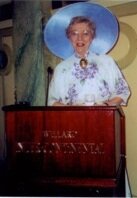Thanks to Dame June Naylor for this article published in Edible Dallas about Dallas Chapter of Les Dames d'Escoffier.
Thanks to Dame June Naylor for this article published in Edible Dallas about Dallas Chapter of Les Dames d'Escoffier.
Formation of the LDEI Dallas Chapter
The Dallas chapter was formed in 1985 as one of the original five chapters that formed Les Dames d’Escoffier International to operate as an umbrella organization for the formation of new chapters throughout the world.
Delores Snyder - Founder of the Dallas Chapter
In 1978, I went to the French Riviera for some R & R after leading a two week food and wine tour for Neiman Marcus to Normandy and the Loire. I had signed up for cooking classes in Michelin starred restaurants—a pilot program designed by Simone Beck. The trip originated in Cannes in early May. The cultural side of the tour included the Matisse Chapel and a visit to Picasso’s home with a cooking class in Simone’s kitchen.
Staying at our hotel was Carol Brock who was leading a group from New York. One day we took an excursion to the home and birthplace of Auguste Escoffier. There, Carol was presented with a medal for founding the New York Chapter of Les Dames d’Escoffier in 1976. She and I discussed the future possibility of a Dallas Chapter.
Time passed and a culinary teacher from Australia visited me in 1983. She asked if I knew what Les Dames d’Escoffier was and I told her of my encounter with Carol Brock during our cooking classes. My Aussie friend had been asked to start a chapter over there. She said,”Dodie, I am going to suggest you start a Dallas Chapter when I am in New York next time.” This was May, 1983 and the following September, I received a letter from Saralie Slonsky inviting me to form a Dallas chapter. I immediately replied but time passed before a reply came. On August 27, 1984, I had the first meeting with my nine charter members. Each immediately replied, “Yes.” when I asked them to meet to form our chapter but each asked, “What is it?”
In 1985 and 1986, I made trips to New York and Washington D.C. to form Les Dames d’Escoffier International.as we now had five chapters. Our formal induction of New York, Chicago, Washington D.C., Dallas and Philadelphia took place on October 27,1986 around the world globe in the lobby of The New York Daily News. There, I lit a candle for Dallas as an official Les Dames d’Escofffier chapter, and all because I was in need of some R and R on the French Riviera.
Carol Brock, LDEI Founder
Carol Brock, founder of Les Dames d'Escoffier, began her long and distinguished career in food journalism in 1944 at age twenty, when she landed her first job as assistant food editor of Good Housekeeping. In her capacity as hostess editor, a position the publication created for her, her responsibilities included recipe development and food photography. She also served as personal chef to Hearst magazine executives and editors, authored a monthly byline in the publication’s “For the Hostess” column, coauthored The Good Housekeeping Party Book and ultimately worked as a contributing editor of three Good Housekeeping cookbooks....
About August Escoffier
The namesake of Les Dames d’Escoffier was the most innovative chef in history, August Escoffier. His philosophy and accomplishments serve as both model and inspiration to culinary professionals today.
Auguste Escoffier began his long and distinguished professional culinary career at the age of 13 and retired 61 years later. During his lifetime, he made French cuisine world famous. Escoffier revolutionized and modernized menus, the art and practice of cooking, and the organization of the professional kitchen. Three of his cookbooks are still regarded as indispensable references.
His culinary innovations included abolishing ostentatious food displays and elaborate garnishes, reducing the number of courses served at a formal meal, lighteningsauces and emphasizing seasonal foods. While respecting and preserving the principles of classical cuisine, he simplified its practice, saying “Because it is simplified on the surface, it does not lose its value. On the contrary, tastes are constantly being refined and cooking must be refined to satisfy them."
He also restructured the kitchen so that it operated as a single integrated unit, a system that prevails today. From medieval times and up to Escoffier, the professional kitchen had been composed of separate independent sections, operating autonomously, which resulted in duplication of labor, waste of food, and inconsistent quality.
Escoffier’s prestige had the ripple effect of elevating the status of cooks from laborers to artists. Kaiser Wilhelm II once said to Escoffier, “I am Emperor of Germany, but you are the emperor of chefs.”
Hotelier Cesar Ritz, whom Escoffier met in 1890, provided not only the stage for the young chef’s talents, but also the audience. Ritz’s illustrious Savoy and Carlton Hotel’s kitchens were headed by Escoffier during an era when international clientele included the rich, the powerful and the famous. Ritz and Escoffier redefined restaurants and raised hospitality to unparalleled heights.
Escoffier’s contributions to culinary art included founding two magazines and writing several books. The best known are guides for the modern chef: Le Guide Culinaire (1903), Le Livre de Menus (1912), and Ma Cuisine (1934). Escoffier’s professional stature was recognized by the French government, which made him a Chevalier of the Legion d’Honneur in 1920 and an Officer in 1928. His memoirs have now been translated into English.






